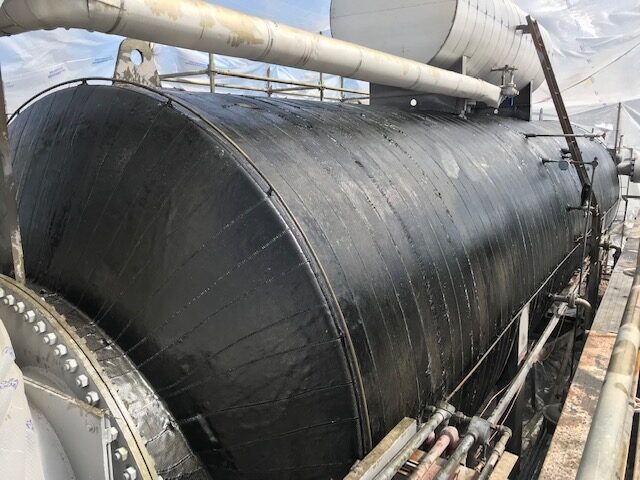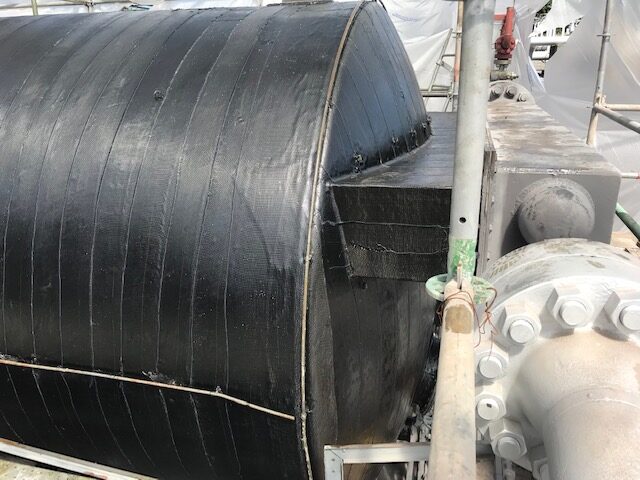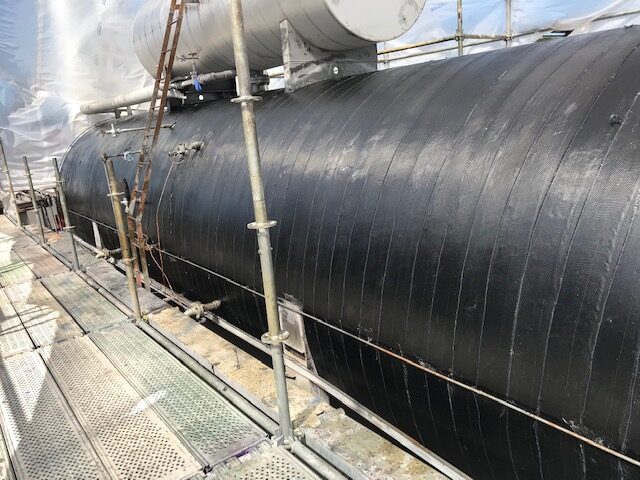Pennsylvania
PIPE DETAILS
- A 10-foot (3-m) high, 35-ft (10.7-m) long glycol salt bath heater suffered from corrosion under insulation (CUI)
- 80% wall loss in multiple areas
- 300°F (149°C) Operating Temperature
Summary
- A 10-foot (3-m) high, 35-ft (10.7 m) long carbond steel bath heater suffered from CUI
- 2 layers of DiamondWrap MT carbon fiber were applied over the entire unit
- 3 technicians completed the repair in less than 3 eight-hour shifts
- No hot work was required
- No negative environmental impact
- Prevented lost revenue by avoiding taking the system offline
Indirect bath heaters are commonly used in many capacities – to heat crude oil, high-viscosity fluids, high-pressure hydrocarbon gas streams, and fuel gas at power generation sites and compressor stations. Unfortunately, corrosion under insulation (CUI) is also common, and over time, many bath heaters experience this type of degradation.
When an inspection at a power and energy company uncovered multiple areas of CUI on a glycol salt bath heater at a compression station, there was an immediate move to restore safety. Some areas of the carbon steel unit had experienced up to 80% wall loss, which introduced an element of urgency for the repair. Bath heaters are big and expensive to replace, and there is a long lead time for replacements, so finding a solution that would allow the unit to function safely while a new one was ordered would save the company from having to lose production from taking the damaged bath heater offline during the high-demand winter months.
The first solution considered was to simply recoat the surface, but it soon became apparent that this would be inadequate because it could not safely restore integrity. Through a local distributor of CSNRI products, the company reached out for an alternative solution.


Composite experts at CSNRI evaluated the condition of the bath heater and recommended using DiamondWrap® MT for the repair.
Although the bath heater was under low pressure, the unit needed to be stable under operating temperatures up to 300°F (149°C). The DiamondWrap system with a high-temperature epoxy was an ideal solution. This repair uses a bidirectional weave of carbon fiber and a 100% solids epoxy to create a composite that is stronger than steel.
The structural system forms a pipe around a pipe, and each successive wrap increases the pressure rating. The bidirectional weave provides strength in both the hoop and axial directions and exhibits very little creep over time, ensuring that there is no reduction in strength. Because of its low profile, DiamondWrap can be installed on tees, elbows, straight runs of pipe, confined spaces and irregular surfaces. The straightforward application process enables installation over large areas.
With the decision made to use DiamondWrap to contain the damage, 2 technicians were deployed to the site to wrap the entire bath, which included the entire 10-foot (3-m) diameter, 35-ft (10.7-m) long unit, plus the domes on each end.
The technicians prepared the surface and began applying two layers of the composite system, completing the project in 3 eight-hour shifts.
The completed solution delivered a layer of corrosion-resistant reinforcement on top of the original pipe that will allow the unit to work safely while a new vessel is being built to replace the corroded unit.
The quick installation of this long-lasting composite repair enables continuing safe service, eliminating the considerable cost of taking the unit offline and removing the threat of environmental damage.


